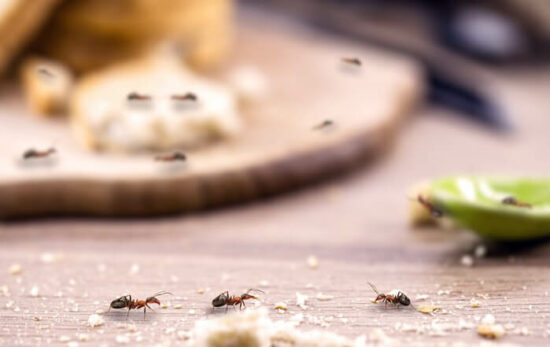It’s important to know how to get rid of ants in the kitchen, because this is the area where you’re most likely to see these insects! The presence of food makes it a very attractive place for ants, which can result in a whole slew of problems for you later on.
This guide will teach you how to get rid of ants in your kitchen, and prevent them from coming back.
Table of contents
How Did Ants Get Into Your Kitchen?
Ants are one of the worst uninvited guests to lurk around your home. Not only do they cause a lot of discomfort, but many ants can carry diseases. Plus, they get just about everywhere and are capable of hiding in the most annoying places.
One of the most common places you’ll spot these bugs is in the kitchen. Depending on where your kitchen is located, you might be scratching your head trying to figure out how they entered in the first place.
Quick Tip: Several different kinds of ant species can invade your home, but all of them are tiny enough to crawl through the smallest of openings. In most cases, they enter through discrete cracks and holes you never knew existed.
- Kills common household ants including acrobat, crazy, ghost, little black, odorous house, pavement, and other sweet-eating ants
- As worker ants discover the bait, they share it with the rest of the colony to eliminate them all
- You should see a significant decrease in the number of ants visiting the bait stations within just a few days
- Place stations near areas where you’ve seen ant activity
Typically, ants will start their lives outside. They might set up a colony close to doors, windows, and other access points. Eventually, scout ants follow a scent trail to make their way indoors (and often into your kitchen).
Once that happens, it’s only a matter of time before the rest of the nest follows! Ants will take advantage of every millimeter of space they can to crawl through barriers. These pests can creep under cracked weatherstripping on doors, around loose window frames, and through small bends in window screens.
They can even take advantage of cracks in your exterior siding to make their way through seemingly solid walls. There’s no end to what ants can do. If there’s a way to get in, they’ll find it!
How To Get Rid Of Ants In Your Kitchen
Seeing these creepy crawlies making their way across your kitchen counters or floors is never fun. But before you start panicking, there are plenty of ways to deal with them.
Ants are resilient creatures. However, they’re no match for the following extermination techniques.
1. Clean Up The Kitchen
The first thing you’ll want to do is give your kitchen a thorough cleaning. That might sound like a given, but it can have a more significant impact on ant issues than most people realize.
It’s easy for kitchens to get messy. That’s where you cook, and most of the perishable items you have in your home go through the kitchen at some point. There are tons of ant attractors in there, and things can get out of hand pretty quickly!
Keeping the room clean is one of the best ways to get rid of ants in your kitchen. We’re not talking about simply wiping down surfaces and cleaning dishes. You need to go all in and clean up the space from top to bottom! Don’t forget to get rid of any ants in your kitchen sink as well.
Remember, ants can survive on tiny crumbs and stray droplets of water. You can’t assume that you’ve picked up all possible food sources with just minimal cleaning.
Go the extra mile! Wipe down counters, sweep the floors, mop, and more. Pay close attention to dark kitchen cabinets or awkward corners where ants can hide.
Quick Tip: It might sound like overkill, but it may be beneficial to move appliances temporarily. You’d be surprised by what kinds of gunk can accumulate behind stoves or under refrigerators. Be as thorough as possible to remove all remnants of food that ants can consume.
2. Don’t Leave Food Out
After you’ve cleaned every inch of your kitchen, think about how you store food.
You should never leave food out in the open longer than a few minutes. It might be tempting to leave some snacks sitting on your counters. For example, many people leave fruits, cookies, and other slow-perishing foods out.
While that may save some room elsewhere and make snacks more accessible, that habit will not do you any favors in the pest department! Ants are naturally attracted to food. Once they find it, those scouts will establish scent trails to guide others right to your kitchen.
Having some food sitting out might not seem like a huge deal at first. But that scent can waft through the air and attract nearby ants like a magnet (meaning you’ll need to get rid of more ants in your kitchen later).
Locking food away as best as possible will help you avoid all that. Keep fresh food in the fridge and put away leftovers once you finish eating. For all other foods, use an airtight container. Not only do tightly sealed containers physically prevent ants from getting in, but it also stops the scent from drawing them near.
The same rules should apply to water as well. Clean up cups and drop the habit of soaking dishes overnight.
3. Place Ant Bait
If you want to get rid of ants in your kitchen, you have to tackle the problem at the source. These bugs work and live to support the entire collective colony. While you might squash a few ants as you see them, you’re not doing much to address the issue at large.
- Kills common household ants including acrobat, crazy, ghost, little black, odorous house, pavement, and other sweet-eating ants
- As worker ants discover the bait, they share it with the rest of the colony to eliminate them all
- You should see a significant decrease in the number of ants visiting the bait stations within just a few days
- Place stations near areas where you’ve seen ant activity
Ant bait can help you see impressive results. These products work by taking advantage of the insect’s penchant for bringing food back to the nest. The bait usually contains toxins that destroy the bug’s nervous system.
However, they don’t work immediately. They’re slow-acting, and most ants won’t feel the effects until much later. As a result, these bugs have plenty of time to be generous and bring it back to the colony. By the time the original scout ants start dying off, the poison has already made its way around the nest.
Ant baits are readily available and come in many different forms. You can find gels, liquids, powders, and more. Generally, these traps contain sugar or fat-based bait foods.
Either way, choose a product that’s easy to use and place. Most come with protective housings, but you’ll want to read the instructions to ensure that you’re using them safely. Place many bait stations around your kitchen to ensure that the ants take it back to the nest!
4. Sprinkle Diatomaceous Earth
Here’s a natural way to get rid of tiny ants in your kitchen that’s extremely effective.
Diatomaceous earth is a powdered substance made out of crushed-up diatoms. While the powder is smooth-looking and safe to handle, it’s downright lethal for insects.
When an ant comes into contact with diatomaceous earth, the powder creates tiny cuts that eventually dehydrate the ant. It’s a powerful product that can take care of ant problems and other infestations.
Pick up a bag of food-grade diatomaceous earth. You’ll find this powder made for pools, lawns, and other applications. Stick to the food-grade variety, as it’s safe for use in your home.
Sprinkle the powder around areas in the kitchen where you’ve seen ants. You don’t need a ton of it to see results, so use a light hand when applying it. Focus on spots under cabinets, on countertops, and anywhere else you’ve seen these pests.
If you know where their established scent trails or entry points are, treat those spots thoroughly! The best way to use diatomaceous earth is to put it in unavoidable areas that ants must cross to get into your kitchen. The pests will either turn away and look elsewhere for food or brave the danger and die. Either way, it’s a win-win situation.
5. Use Vinegar & Water
Vinegar is a pretty standard product to have in the kitchen. Not only is it suitable for cooking, but many people utilize it for things like sanitization and cleaning. It also works well to get rid of small ants in your kitchen!
In a clean spray bottle, create a one-to-one mixture of vinegar and water. You’re free to use either white vinegar or apple cider vinegar. Both are effective, but most prefer to use white vinegar because of its colorless nature.
There are a couple of ways to use your vinegar solution. When you see ants on the spot, spray them down! The acidic liquid will break down the protective cuticle on the ant’s body, essentially drowning and killing them.
Once the ants are dead, use a paper towel or cloth to pick up the bodies, and you’re good to go!
Another option is to use vinegar to treat scent trails. The smell of vinegar is far too strong for ants. It masks the pheromones they leave behind and makes the area unbearable to be around.
Spray it on the trails to erase them. Then, use it on potential access points to keep the ants out. The pungent smell of the vinegar should be enough to deter the ants. All the while, the solution is safe and non-irritating for you, pets, and children.
6. Try Borax
Earlier, we mentioned using commercial ant bait traps. If you don’t want to use store-bought chemical products, you can turn to borax to kill ants.
Available at most grocery stores, borax is a powdered compound that slowly poisons ants. In its raw powdered form, it’s primarily used as soap or laundry detergent. It’s cheap, readily available, and surprisingly effective at killing ants.
Like bait traps, the borax kills ants slowly, allowing them to spread it throughout the colony. The powder interferes with the digestive system.
To use borax, mix it with something the ants like to eat. Some of the most common bait foods are peanut butter and powdered sugar. The former option transforms the borax into a moldable putty, which is great for sticking in awkward places.
Put your homemade traps near known areas that ants travel through. If you use this method to get rid of ants in your kitchen, expect to wait a few weeks before you’ll see the final results.
Quick Tip: Make sure to exercise some caution when working with borax. It’s considered to have low toxicity, but there are still some risks involved. Make sure to place the bait in spots that young kids or pets can’t access.
7. Seal Up Openings
Our last tip for getting rid of ants in the kitchen is to seal up as many openings as possible.
It’s not always practical to seal up everything and turn your kitchen into an impenetrable fortress. However, you can be proactive about addressing discrete access points.
Inspect your kitchen closely and look for tiny cracks, voids, and other entry points. Pay attention to any doors or windows you might have. Framing can settle over time, resulting in little gaps.
Weatherstripping is another common problem. As it wears, the rubber or foam reveals tiny openings that ants can take advantage of to enter your home.
Seal up any openings you find using all-purpose silicone-based caulk. Caulking is available in many colors, so you can easily find one that blends into your existing decor.
Spread it evenly and close all possible entryways for the ants! That way, none can return and use your kitchen as free feeding grounds anymore.
Ways To Keep Them Off Your Kitchen Counter
Ants are agile little creatures that can climb on nearly any surface to get food. While many homeowners spot them on the floors, ants often make their way onto kitchen counters as well. It’s not uncommon to wake up one day and find a well-formed line of ants marching to your fruit basket or snack jar!
The best way to get rid of ants on your kitchen counter is to use an all-natural spray. You want to avoid using chemical-based sprays on your countertops, as you likely use them to prepare food. Not only that, but harsh chemicals can easily mar natural stone surfaces like granite or marble.
Instead of grabbing the insecticide, consider using a natural spray of vinegar or soap.
The vinegar spray solution we went over earlier works well. It can kill ants on the spot while also erasing any established scent trails.
To use soap, fill a spray bottle with clean water and add a few drops of dish soap. Like vinegar, the soap will dissolve the protective cuticle on the ant’s body. The ant can’t repel water or escape the spray when this happens, so it drowns and dies.
Natural sprays can do a lot to take care of ants in the heat of the moment. They won’t address more extensive infestations, so you’ll need to adopt the previous extermination methods we discussed for lasting results. However, the sprays can provide some quick results and help you get rid of ants on your kitchen counter.
Quick Tip: The best way to prevent ants from going on your countertops at all is to keep them food-free. Wipe up any messes and make sure that no crumbs get left behind. Put away food and make sure that your counters have nothing to draw the ants in.
What Attracts Them?
For ants, survival is the name of the game. These bugs don’t end up in your kitchen for the sake of invading your personal space. They set out to find the means of survival, and your kitchen just so happens to have a number of things that attract them.
Your kitchen is like a buffet of the two critical survival resources, food and water.
Food and water are why scouts meander their way into your home undetected in the first place. Those workers pick up scent trails to the food you’re cooking or the crumbs you leave behind. It’s what draws them in and encourages those scouts to call in the troops.
The same goes for water. Kitchens are some of the messiest places in your home. Even if you do your best to keep things clean, stray crumbs and water drops are bound to go undetected.
Ants frequently check floors and countertops for any morsel of food they can find. Many will also make their way into pantries and other food storage areas.
Once they find food and water, ants will stick around for the long haul. They may set up a new colony and start reproducing to increase their numbers. All this can occur right under your nose in the kitchen!
Types Of Ants That Are Found In The Kitchen
When most people see ants in their kitchen, they’re more concerned with getting rid of them as opposed to identifying them. However, knowing your enemy can make all the difference! Several types of ants are known to infiltrate homes.
Each species responds to extermination methods differently. That’s because they’re attracted to different things. Some ants like sweets while others stick to grease and fat!
Knowing those subtle differences allows you to use the most effective extermination technique you can.
The most common ant species you’re likely to encounter are the pavement, Argentine, pharaoh, and carpenter ant.
Pavement and Argentine ants look pretty similar. They’re usually dark brown or black, earning them the umbrella moniker of “little black ants.”
Argentine ants are slightly smaller than pavement ants, but the size difference is barely distinguishable unless you have them side by side. Both of these species also eat a wide variety of foods, so they’ll usually take both sugar and fat-based bait products.
Pharaoh ants are only a couple of millimeters long and usually take on a tan or off-white color. Regular kitchen invaders, these bugs gravitate to meats, grease, and smaller bugs like aphids. They’ll occasionally eat sweets, too.
Finally, there are the carpenter ants. The biggest of the bunch, these bugs are pretty easy to identify. Not only are they significantly bigger than other common household species, but they like to burrow in wood and leave behind a trail of destruction.
Quick Tip: Contrary to popular belief, carpenter ants don’t eat wood. Instead, they prefer sweets and plant juices.
Final Thoughts
Getting rid of ants in the kitchen is a surprisingly straightforward process. As long as you limit the amount of accessible food and water, the number of insects you’ll have to deal with should be quite manageable.
Let us know if you have any questions about handling tiny ants in your kitchen. This is an area that a lot of homeowners struggle with, so it’s never a bad idea to ask for some help!



